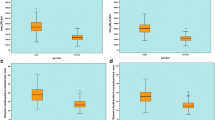Summary
Thirty untrained subjects (group 1: 10 ♀, 20–30 years; group 2: 10 ♀, 36–46 years; group 3: 10 ♂, 20–30 years) performed dynamic hand work on a hand-grip dynamometer at loads varying from 20 to 100% MVC and three different working frequencies (20, 40, and 60 cpm). The mechanical muscle activity, the iEMG and the R-R interval were measured throughout the exercise. Before and after each exercise, the maximal hand-grip force (MVC) was determined together with the iEMG and the R-R interval.
With the loads increasing gradually, the mean values of the duration of the contraction phase and of the iEMG of the four muscles increased in all test groups, but the duration of the rest phase and R-R interval decreased. Through an Analysis of Variance, evidence of systematic differences between the test groups was significant for the R-R interval only, while the effects of the loads (with exception of the rest phase) and of the working frequency proved significant for all parameters.
The MVC, the iEMG and the R-R interval measured before and after the exercise did not show significant differences. This indicates that the exercise was not fatiguing.
Similar content being viewed by others
References
åstrand PO, Rodahl K (1970) Textbook of work physiology. McGraw-Hill, New York
Buzunov VA (1979) Osobennosti somatičeskoj i vegetativnoj reguljacii pri rabote malych grupp myšc v zavisimosti ot reŽima nagruzki. Fiziol čeloveka 4: 607–612
Donskaja LV (1978) Povyšenie effektivnosti ručnogo truda v uslovijach mechanizirovannogo i avtomatizirovannogo proizvodsta. In: Fiziologičeskie osnovy povyšenija effektivnosti truda. Nauka, Leningrad, pp 29–36
Einars W (1979) Elektromyographie als arbeitswissenschaftliche Methode zur Beurteilung von lokaler Belastung, Beanspruchung und Ermüdung bei dynamischer Muskelarbeit. Diss Techn Univ München
Jeschke D, Bayer Ch, Grewe N, Haasis R, Immich H, Kutsche B, Philipp R, Schaumann HJ, Stauch H, Tschirdewahn B (1980) Ergometrische Normbereiche für die klinische Praxis. In: Nowacki PE, Böhmer D (eds) Sportmedizin. Thieme, Stuttgart New York, pp 152–158
Karvonen MJ (1979) Ergonomic criteria for occupational and public health surveys. Ergonomics 22: 641–650
Kobryn U, Hoffmann B, BrÄuer D, Bastek R, Küchler G, Minuth B (1977) MuskelaktivitÄt und Herzschlagfrequenz bei rhythmischer Arbeit am Handergometer. I. Herzschlagfrequenz, bioelektrische MuskelaktivitÄt und Mechanogramm in AbhÄngigkeit von der KontraktionsstÄrke. Acta Biol Med Ger 36: 1253–1262
Kobryn U, Hoffmann B, BrÄuer D, Küchler G, Bastek R (1978) MuskelaktivitÄt und Herzschlagfrequenz bei rhythmischer Arbeit am Handergometer. II. Herzschlagfrequenz, mechanische und bioelektrische MuskelaktivitÄt im Verlaufe gestufter Belastungen und in Beziehung zur maximalen Arbeitsdauer. Acta Biol Med Ger 37: 623–631
Laurig W (1974) Beurteilung einseitig dynamischer Muskelarbeit. Schriftenreihe „Arbeitswiss u Praxis“, Bd. 33. Beuth-Vertrieb, Berlin Köln Frankfurt am Main
Lehmann M, Keul J, Huber G, Bachl N, Simon G (1981) Alters- und belastungsbedingtes Verhalten der Plasmacatecholamine. Klin Wochenschr 59: 19–25
Martin K (1982) Untersuchungen von Ermüdung und Erholungszeiten bei einseitig dynamischer Muskelarbeit. Fortschr Ber VDI-7, Reihe 17, Nr 10, Düsseldorf
Onishi N, Nomura H (1976) On the endurance time of sustained and rhythmic intermittent contractions of hand grip and wrist extension. J Sci Labour 52: 527–540
Petrofsky JS, Lind AR (1975) Isometric strength, endurance, and the blood pressure and heart rate responses during isometric exercise in healthy men and women, with special reference to age and body fat content. Pflügers Arch 360: 49–61
Petrofsky JS, Burse RL, Lind AR (1975) Comparison of physiological responses of women and men to isometric exercise. J Appl Physiol 38: 863–868
Tchorevskij VI (1973) Otčet po teme „Eksperimental'noe izučenie izmenenija krovosnabŽenija rabotajuščich myšc, arterial'nogo davlenija, častoty pul'sa i regionarnogo sosudistogo soprotivlenija v uslovijach statičeskoj i ritmičeskoj raboty malych myšečnych grupp“, Moskva
Tchorevskij VI (1975) KrovosnabŽenie myšc čeloveka pri različnych reŽimach ich funkcional'noj aktivnosti. Med Diss Moskva
Author information
Authors and Affiliations
Rights and permissions
About this article
Cite this article
Kobryn, U., Hoffmann, B. Physiological effects of dynamic hand work in subjects of different age and sex. Europ. J. Appl. Physiol. 51, 145–154 (1983). https://doi.org/10.1007/BF00952547
Accepted:
Issue Date:
DOI: https://doi.org/10.1007/BF00952547




